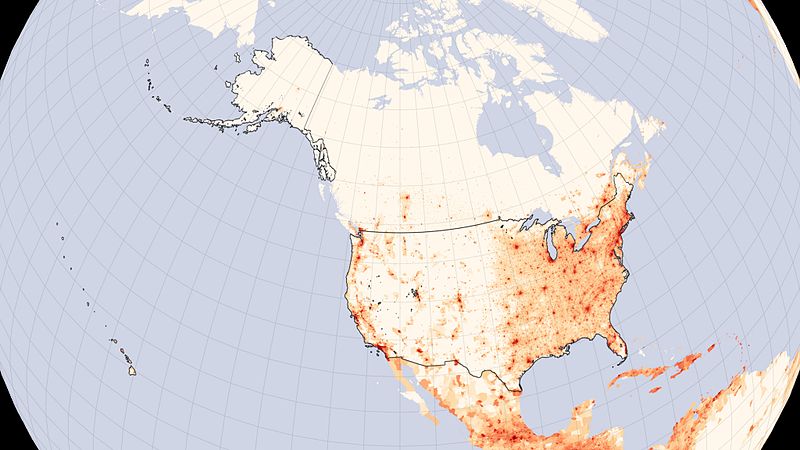File:Us population 2005 lrg.jpg
Page contents not supported in other languages.
Tools
Actions
General
In other projects
Appearance

Size of this preview: 800 × 450 pixels. Other resolutions: 320 × 180 pixels | 640 × 360 pixels | 1,024 × 576 pixels | 1,280 × 720 pixels | 2,048 × 1,152 pixels.
Original file (2,048 × 1,152 pixels, file size: 442 KB, MIME type: image/jpeg)
| This is a file from the Wikimedia Commons. Information from its description page there is shown below. Commons is a freely licensed media file repository. You can help. |

|
This map image could be re-created using vector graphics as an SVG file. This has several advantages; see Commons:Media for cleanup for more information. If an SVG form of this image is available, please upload it and afterwards replace this template with
{{vector version available|new image name}}.
It is recommended to name the SVG file “Us population 2005 lrg.svg”—then the template Vector version available (or Vva) does not need the new image name parameter. |
 | This map image was uploaded in the JPEG format even though it consists of non-photographic data. This information could be stored more efficiently or accurately in the PNG or SVG format. If possible, please upload a PNG or SVG version of this image without compression artifacts, derived from a non-JPEG source (or with existing artifacts removed). After doing so, please tag the JPEG version with {{Superseded|NewImage.ext}} and remove this tag. This tag should not be applied to photographs or scans. If this image is a diagram or other image suitable for vectorisation, please tag this image with {{Convert to SVG}} instead of {{BadJPEG}}. If not suitable for vectorisation, use {{Convert to PNG}}. For more information, see {{BadJPEG}}. |
Summary
| DescriptionUs population 2005 lrg.jpg |
English: The population of the United States reached 300 million on October 17, 2006, said the www.census.gov/Press-Release/www/releases/archives/population/007616.html U.S. Census Bureau. With one birth every 7 seconds, a death every 13 seconds, and a migrant entering the country every 31 seconds, the United States' population is growing at a rate of one person every 11 seconds. Where are all of these people living? This map, based on population estimates made in 2005, charts out the number of people in every square kilometer of the United States. As has been the case historically, the most densely populated parts of the United States are east of the Mississippi River. Rings of decreasing population density radiate out from the major urban centers of New York, Philadelphia, and Washington along the East Coast. Other cities -- Atlanta, Chicago, Houston, and Dallas -- punctuate the map in the country's interior. The west remains lightly populated except for clearly defined urban regions. Like their counterparts in the east, the largest cities in the west (San Diego and Los Angeles in the south; San Francisco, Oakland, and San Jose farther north) hug the coast, with the densest populations in Southern California. Other large western cities readily visible here include Portland, Seattle, Phoenix, and Denver. For Earth scientists, population density maps can be crucial in answering questions about the relationship between people and the environment. How does population density relate to changes in land cover? How are natural resources distributed in relation to population? How do densely populated regions, with their pollution, artificial surfaces, and urban heat islands, affect climate? To answer these and other questions, scientists compare detailed population maps to other geographically based data sets, including satellite data. In the comparison, trends that track the human footprint can emerge. This particular population density map is based on a sedac.ciesin.columbia.edu/gpw/index.jsp global population density map created at the sedac.ciesin.columbia.edu/index.html Socioeconomic Data and Applications Center (SEDAC) at Columbia University. One of the Distributed Active Archive Centers in NASA's Earth Observing System Data and Information System, SEDAC provides information about human interactions in the environment.
|
| Date | |
| Source | http://earthobservatory.nasa.gov/IOTD/view.php?id=7052 |
| Author | NASA -- NASA image by Robert Simmon, based on data archived by the sedac.ciesin.columbia.edu/ Socioeconomic Data and Applications Center |
Licensing
| Public domainPublic domainfalsefalse |
| This file is in the public domain in the United States because it was solely created by NASA. NASA copyright policy states that "NASA material is not protected by copyright unless noted". (See Template:PD-USGov, NASA copyright policy page or JPL Image Use Policy.) |  | |
 |
Warnings:
|
Captions
Add a one-line explanation of what this file represents
Items portrayed in this file
depicts
24 October 2006
452,770 byte
1,152 pixel
2,048 pixel
image/jpeg
26d122fa0d84ab52e3eebad37b4e1890217e1ae0
File history
Click on a date/time to view the file as it appeared at that time.
| Date/Time | Thumbnail | Dimensions | User | Comment | |
|---|---|---|---|---|---|
| current | 22:24, 3 July 2016 |  | 2,048 × 1,152 (442 KB) | Proud User | User created page with UploadWizard |
File usage
The following 2 pages use this file:
Global file usage
The following other wikis use this file:
- Usage on cs.wikipedia.org
- Usage on uk.wikipedia.org
Metadata
This file contains additional information, probably added from the digital camera or scanner used to create or digitize it.
If the file has been modified from its original state, some details may not fully reflect the modified file.
| Orientation | Normal |
|---|---|
| Horizontal resolution | 72 dpi |
| Vertical resolution | 72 dpi |
| Software used | Adobe Photoshop CS2 Macintosh |
| File change date and time | 17:54, 24 October 2006 |
| Y and C positioning | Centered |
| Exif version | 2.21 |
| Date and time of digitizing | 17:54, 24 October 2006 |
| Meaning of each component |
|
| Supported Flashpix version | 1 |
| Color space | 0 |
| Scene capture type | Standard |
| Image width | 2,048 px |
| Image height | 1,152 px |
| Date metadata was last modified | 13:54, 24 October 2006 |
Retrieved from "https://en.wikipedia.org/wiki/File:Us_population_2005_lrg.jpg"

